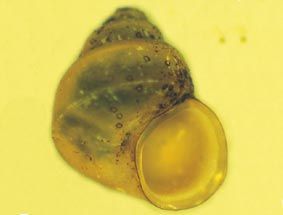Major Group: Gastropoda
Order: Neotaenioglossa
Family: Bithyniidae
Genus: Gabbia
This family is represented in Australia by a single genus, Gabbia. |
Descriptive Features: shells coiled (almost always dextral)
radula with 7 teeth in each row (central, and a pair of marginal and lateral teeth - taenioglossan condition)
eyes located on outer side (usually at base) of tentacles
sexes typically separate, rarely protandric hermaphrodites
eyes typically on bulges at outer sides of tentacle bases
also distinguished by ultra structural differences in the osphradium, sperm etc
shells small, coiled, dextral, typically conical (but can be flattened to elongate)
aperture lacks an anterior channel
penis typically attached to right side of head behind right tentacle (sometimes almost central on head)
penis bifid
Size: |

|
Gabbia australis |
|
|
|
Taxonomic Checklist: Species
Gabbia adusta Ponder
Gabbia affinis Brazier ms Smith
Gabbia beecheyi Ponder
Gabbia campicola Ponder
Gabbia carinata Ponder
Gabbia clathrata Ponder
Gabbia davisi Ponder
Gabbia fontana Ponder
Gabbia iredalei Cotton
Gabbia kendricki Ponder
Gabbia kessneri Ponder
Gabbia lutaria Ponder
Gabbia microcosta Ponder
Gabbia napierensis Ponder
Gabbia obesa Ponder
Gabbia pallidula Ponder
Gabbia rotunda Ponder
Gabbia smithii Tate
Gabbia spiralis Ponder
Gabbia tumida Ponder
Gabbia vertiginosa Frauenfeld |
|
Distribution: SW WA, N WA, N NT, Qld, NSW
Sensitivity Rating: SIGNAL grade 3
Functional Feeding Group: scrapers |

|
Howard Springs, Darwin NT |
|
|
Ecology: Instream habitat: Gabbia australis occurs in slow flowing and still waters such as the backwaters or rivers and billabongs.
Feeding ecology: Gabbia australis snails are grazers of periphyton.
Habit:
Life history: |
| |
Information Sources: Ponder 2001, 2003, 2013, Smith 1992, 1996, 2002c, Gooderham & Tsyrlin 2002
Key to Species: Ponder 2003 |
|
|
|